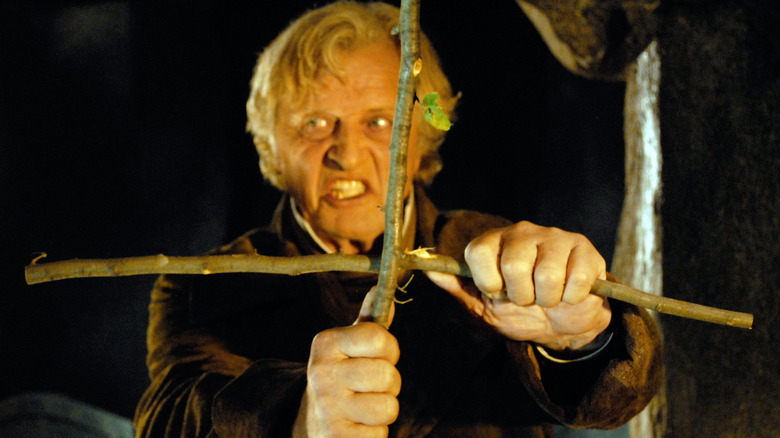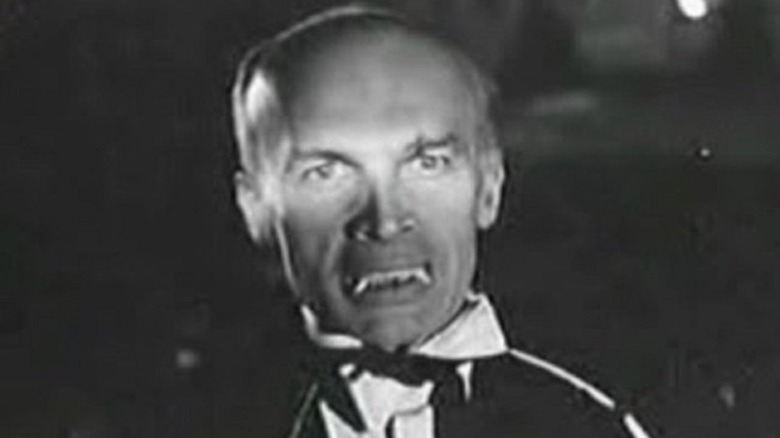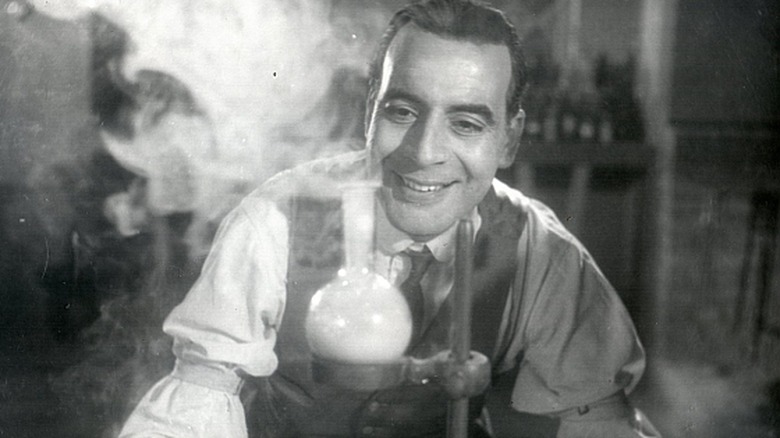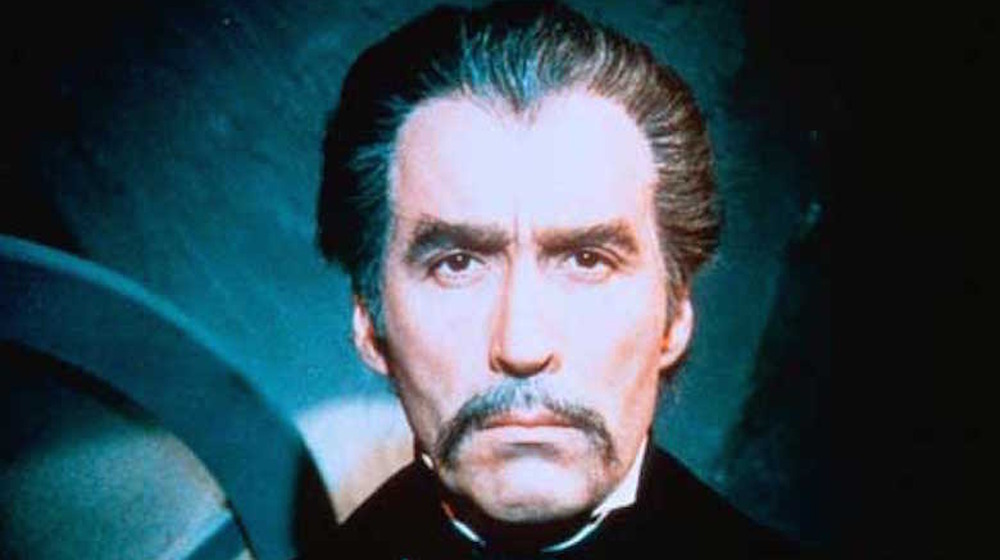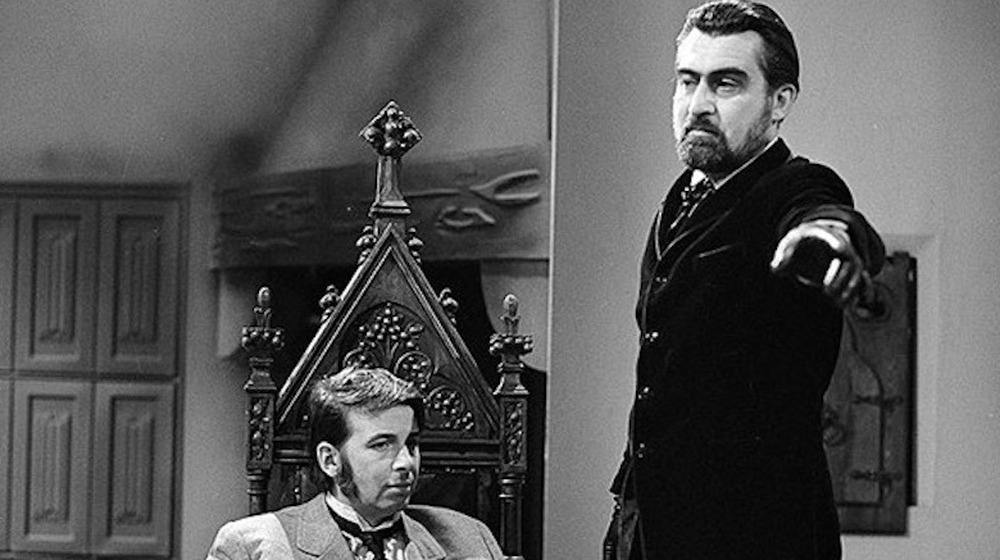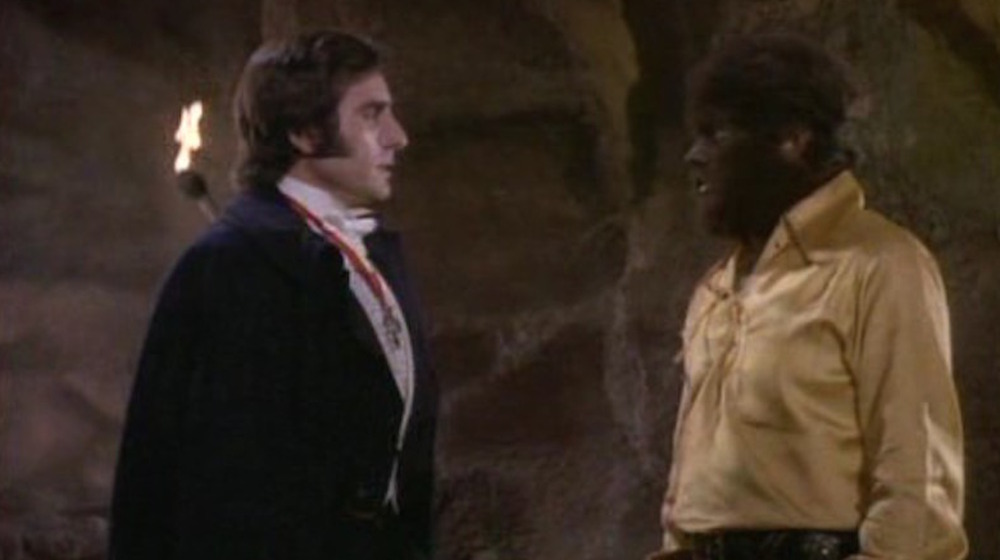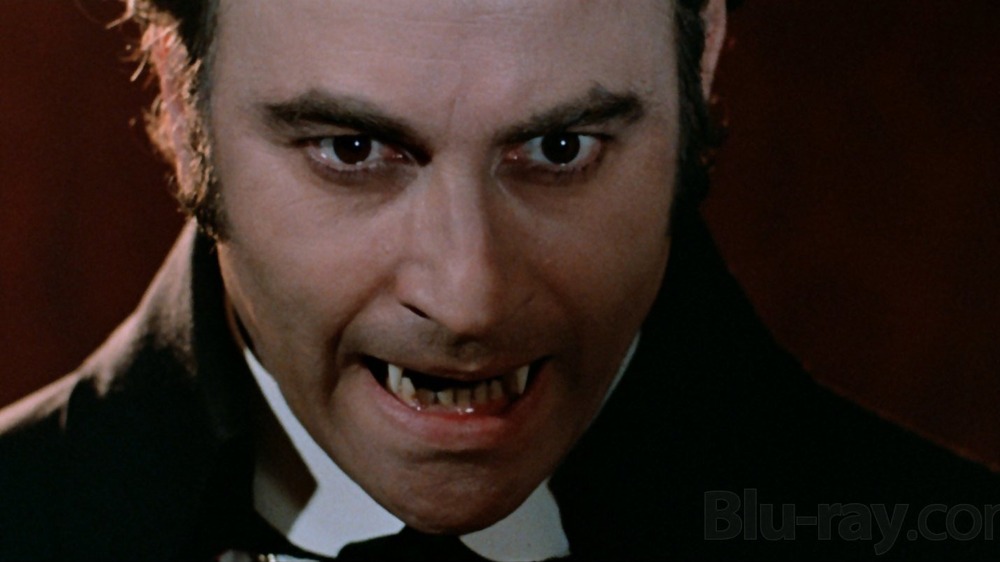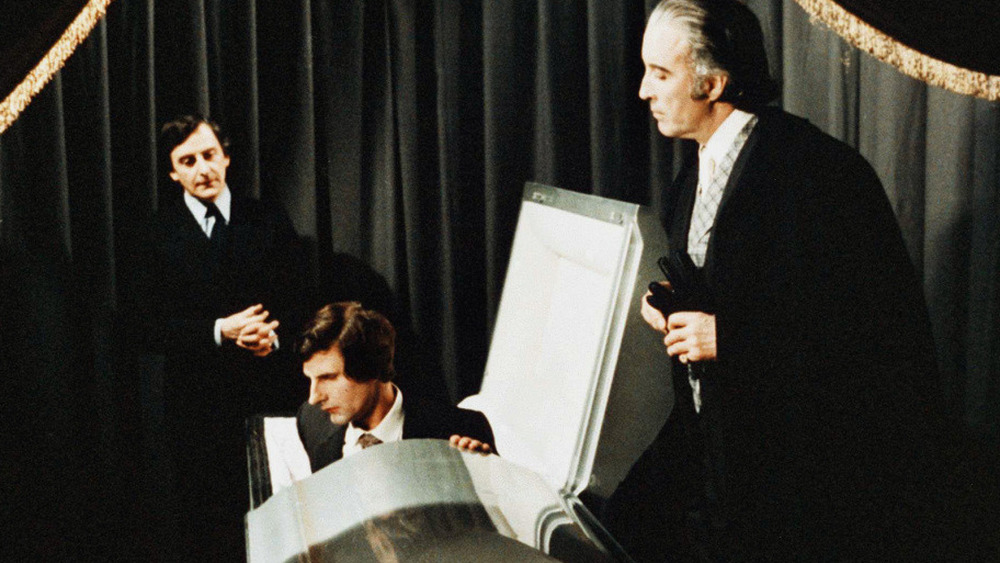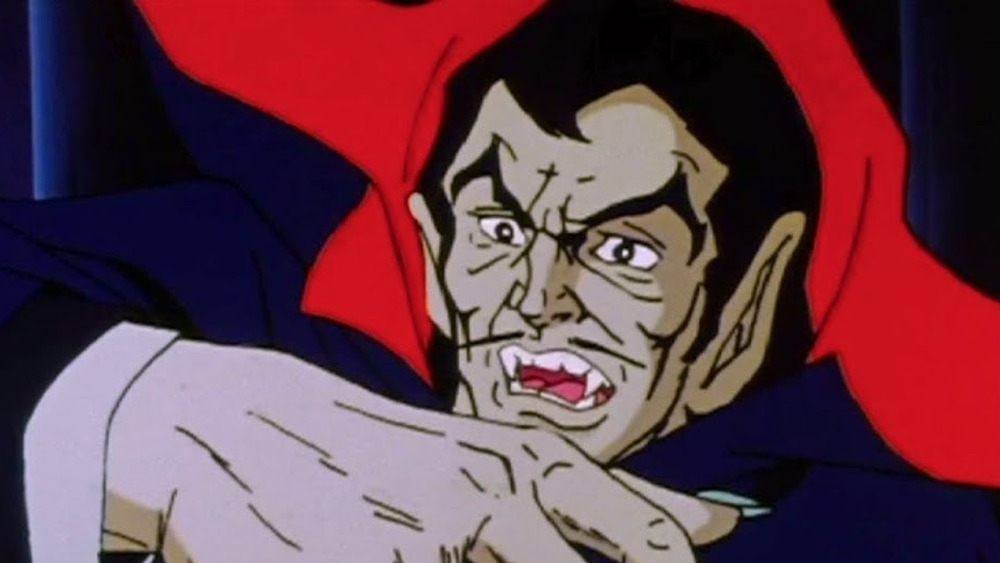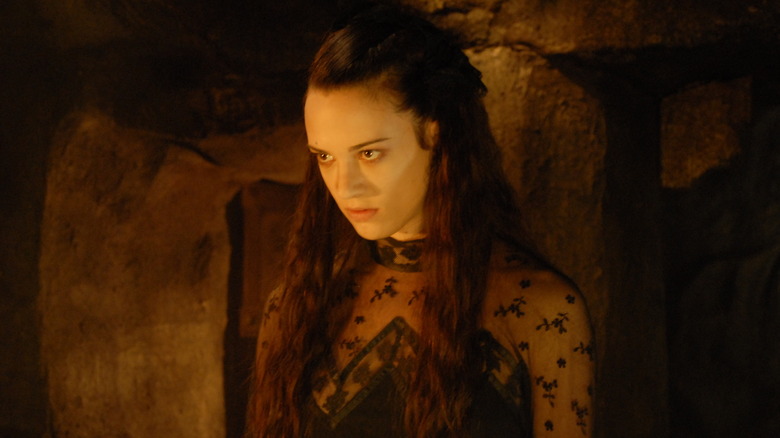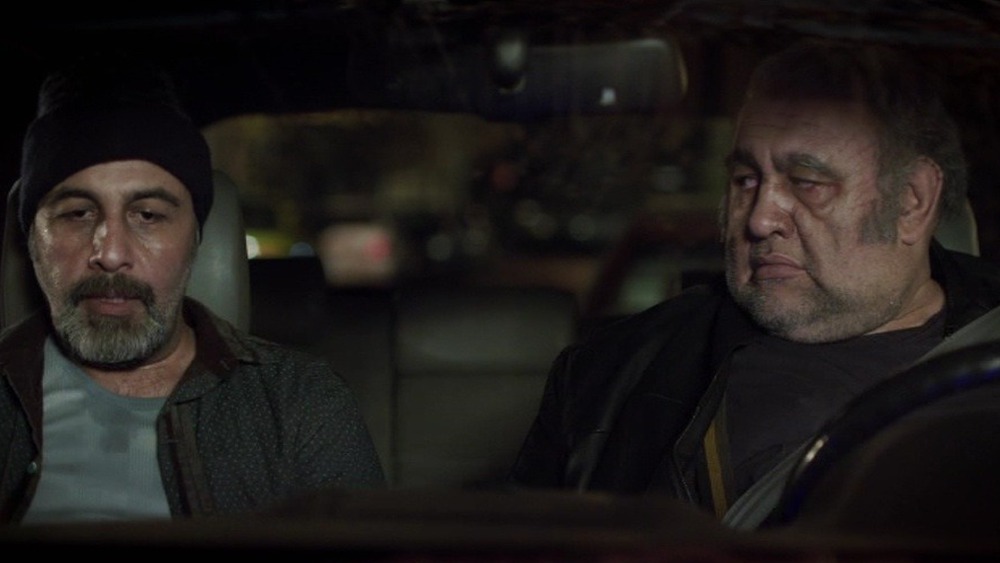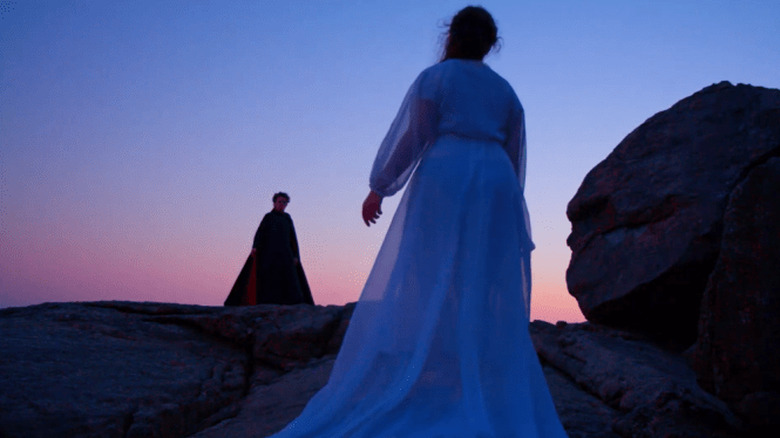Bizarre International Versions Of Dracula
When you think about movie Draculas, who comes to mind? Bela Lugosi, no doubt: his take in Tod Browning's 1931 version is still indelible after 90 years. Christopher Lee's sensual turn as the Count for Hammer Films, beginning with 1958's Horror of Dracula, may surpass Lugosi for many fans, as might Gary Oldman's doomed romantic in Francis Ford Coppola's 1992 adaptation, Bram Stoker's Dracula. There's also the fabulously freaky Udo Kier in 1974's Blood for Dracula (also known as Andy Warhol's Dracula), Frank Langella's swoon-inducing turn in John Badham's Dracula (1979), Max Schreck as Count Orlok — a name change necessitated to avoid legal action by Bram Stoker's estate — in F.W. Murnau's Nosferatu (1922) and even Claes Bang in the more recent 2020 TV adaptation.
But even this is only the tip of the iceberg. The King Vampire has been adapted for the screen by countless international filmmakers. Some, like Blood for Dracula, earned theatrical release in America, but dozens more have gone unseen by English-language audiences, or have only recently come to their attention through home video and online resources. Many offer interpretations of Dracula based on established and popular films, while others filter their own cultural and artistic sensibilities through him. Like so many enduring characters, Dracula contains multitudes, and seems able to withstand any number of adaptations while still retaining his power to chill and thrill. Following are some of the most unusual, unique, and offbeat Draculas on film from all points on the globe.
Warning: spoilers may follow.
A bald Count haunts Dracula in Istanbul
Dracula Istanbul'da (Dracula in Istanbul) is an adaptation of an adaptation: the story is based on Kazikli Voyvoda, a Turkish translation and partial rewrite of the Bram Stoker novel that, like its 1953 film adaptation, moves the action from Romania and London to Istanbul. Like the book, the film is fairly faithful to the source material, with some exceptions: its bald-pated Dracula (Atif Kaptan) is kept at bay with garlic, not crucifixes (appropriate for a Muslim country) and has a hunchbacked assistant with a prodigious mustache in the place of Renfield. Its Mina Harker is also a far cry from Stoker's heroine: here, she's a belly dancer named Guzin.
Mehmet Muhtar's direction is atmospheric and takes its cues from both Tod Browning's Dracula and F. W. Murnau's Nosferatu; location aside, Dracula Istanbul'da's most notable aspect is its contributions to movie vampire lore. It's also reportedly the first film to show Dracula with fangs (pre-dating Christopher Lee in Horror of Dracula by five years), the first to explicitly connect him to Vlad the Impaler, and the first to show the Count scaling face-first down his castle walls.
You call that Living? It's Dracula in Pakistan
Zinda Laash, which is alternately known as Dracula in Pakistan or The Living Corpse, purports to be based on Bram Stoker's Dracula, but this 1967 Urdu-language feature bears a closer resemblance to Terence Fisher's Horror of Dracula. That's not to say it's a remake –- its Dracula figure (played by Mir Rehan) is a scientist who becomes a vampire after consuming his own concoction, a potion that grants eternal life — but as UK critic and author Kim Newman and others have noted, director Khwaja Sarfraz models a great deal of his modern-day monster picture after the groundbreaking Hammer vampire film.
Rehan bears a strong resemblance to Christopher Lee's Count, and whole scenes are staged — like the finale, complete with sunlight through thrown-open shades — in a manner similar to Fisher's direction. Of course, it's the differences that distinguish the film, which include a car chase to the professor's lair, an eclectic soundtrack that mixes classical, experimental, and '60s instrumental rock with a heavy twang. This being a Lollywood film, there's also room for several song and dance numbers.
Count Dracula aims for a faithful adaptation
One of Christopher Lee's primary complaints about Hammer's Dracula franchise was how far each film deviated from Bram Stoker's novel. So the idea of a faithful adaptation, as 1970's Count Dracula was initially billed, must have motivated his reprisal of the vampire king in this Spanish/Italian/West German/UK production. And while the film, directed and co-written by prolific exploitation filmmaker Jesus (Jess) Franco, does have moments that hew closer to the source material than, say, Bram Stoker's Dracula, it lacks the money and the drive to mount anything more than a modest, Classics Illustrated interpretation that suffers under Franco's disinterested, distracted direction.
On the plus side, it does feature a fine turn by Lee as an initially aged Dracula who grows younger after each feast of blood (a notion found in the Stoker novel), solid support from Herbert Lom as Van Helsing and Klaus Kinski as a suitably bonkers Renfield, and impressive Spanish locations and sets. Franco would feature Dracula, or distant relations, in several other films, including the surreal Dracula, Prisoner of Frankenstein, Daughter of Dracula (both with Franco regular Howard Vernon as the Count), and Killer Barbys vs. Dracula, which is as absurd as it sounds. And for the curious, the 1971 experimental Spanish film Vampir Cuadecuc is constructed from behind-the-scenes footage taken during Count Dracula's production.
Here's a creepy Dracula from '70s Czech TV
Until recently, Hrabe Drakula, which was made for Czechoslovakian television in 1971, was among the most obscure adaptations of the Stoker novel. Time and the Internet have made it more widely available to be seen and appreciated for its faithful interpretation and Gothic atmosphere.
At 76 minutes, the black-and-white Hrabe Drakula – the first screen Dracula directed and co-written by a woman (Anna Prochazkova) — breezes through the storyline, eliminating Renfield, streamlining plot points, and featuring a burly, bearded count (Ilja Racek). But many elements that were dropped from other adaptations, like Dracula scaling the walls of his castle and the mother pleading for her lost infant, are included here, and for a production largely confined to stark sets and modest visual effects, Hrabe Drakula manages to generate an appreciable air of mystery and dread. It's also reportedly the first Dracula to feature Mina (Klara Jernekova) receiving her ghastly "communion" from Dracula by drinking blood from his chest.
Santo has issues with Dracula and the Wolf Man
Mexican wrestling legend El Santo had a problem with vampires. The legendary luchador (Rodolfo Guzman Huerta) fought the creatures of the night on multiple occasions as part of his long screen career, most notably in 1962's Santo vs. the Vampire Women. Santo also faced off against el jefe vampiro, Dracula himself, in two movies: 1969's Santo in the Treasure of Dracula, and 1973's Santo and Blue Demon vs. Dracula and the Wolf Man.
As the latter title suggests, the film is a tag-team of sorts, with Santo and fellow Mexican wrestling great Blue Demon (Alejandro Munoz Morena) battling Dracula (Aldo Monti), his werewolf henchman Rufus (Agustin Martinez Solares), a hunchback, and a small army of fellow lycanthropes. Born in Italy and raised in Venezuela, Monti also played the Prince of Darkness in Treasure of Dracula (and later directed Santo in his 1975 adventure, Anonymous Death Threat), and has both the imposing physique and matinee idol looks required of post-Hammer interpretations of the role, while the action both in and out of the ring is plentiful.
A Spanish werewolf turns vampire in Count Dracula's Great Love
Actor and filmmaker Paul Naschy was best known for playing Polish nobleman and werewolf Waldemar Daninsky in 12 films that earned him cult status in his native Spain and around the world until his death in 2005. The former weightlifter also played other classic monsters during his long career, including Mr. Hyde, a reanimated mummy, and a Dracula in disguise in 1973's El Gran Amor de Conde Dracula (Count Dracula's Great Love).
Naschy, who co-wrote the film under his real name of Jacinto Molina, is unquestionably one of the brawniest King Vampires on film (though not quite as ripped as Dominic Purcell in Blade: Trinity). But he also handles both the monstrous and tragically romantic sides of the character, the latter of which Naschy exercises repeatedly with the majority of his female castmates. This was Naschy's only outing as a vampire, but as Daninsky, he faced off against them on numerous occasions, including his first horror film, La Marca del Hombre Lobo (released in the U.S. as Frankenstein's Bloody Terror), and 1970's La Noche de Walpurgis (a.k.a. The Werewolf vs. the Vampire Woman).
Christopher Lee plays the Count for laughs in Dracula and Son
Christopher Lee officially parted ways with Hammer Films' interpretation of Dracula after 1973's The Satanic Rites of Dracula, though he played the role on two subsequent occasions. The first of these was his stint as narrator of the 1975 documentary In Search of Dracula, for which he also played both Dracula and Vlad Tepes, the real-life inspiration for the vampire. One year later, Lee played Dracula for laughs in the 1976 French comedy Dracula pere et fils (Dracula and Son).
The film has an amusing premise: Dracula, having fathered a son (French actor Bernard Menez) with no stomach for the family's nocturnal proclivities, is ousted from his castle by a Communist uprising and dispatched to London, where he becomes the star of a horror movie based on his resemblance to Christopher Lee (!). Lee himself, in his autobiography Lord of Misrule, described it as the "irrevocable full stop" for any future portrayals of the Count unless it followed Stoker's novel to the letter. By all accounts, the original French-language version of the film wasn't as bad as Lee made it out to be; unfortunately, the only version widely available to English-speaking audiences is an American edit loaded with atrocious puns and "funny" re-edits. Lee's frequent co-star, Peter Cushing, also played a bloodsucker for laughs in a French comedy, 1974's Tender Dracula. Also starring Menez, that film focused on a horror movie star (Cushing) who specialized in vampire roles.
Marvel's Tomb of Dracula gets the anime treatment
A decade-plus before Blade made his motion picture debut, his old Marvel Comics adversary, Count Dracula, got his own screen showcase in the animated feature Dracula: Sovereign of the Damned, which was made for Japanese television in 1980. The film, produced by the Toei Animation Company — which counts the 1984-1990 Transformers, Dragon Ball, and Sailor Moon among its roster of titles — is a loose adaptation of Marvel's Tomb of Dracula (1972-1979) comic book series by writer Marv Wolfman, illustrator Gene Colan, and inker Tom Palmer. It pits the Vampire King against Quincy Harker and Rachel Van Helsing, the descendants of his foes from long ago.
There's a Satanic cult in the mix, which brings to life Dracula's vampire/not-vampire son, Janus, and what appears to be the MCU's on-deck mega-villain, Mephisto (called Satan in the English-language dub), but no Blade or Hannibal King, the breakout stars of the series. The animation is serviceable, but the plot trades coherence for a disco sequence and the sight of Dracula eating a burger in New York, which, while not Fred and Barney meet the Thing level of Bad Marvel Animation, is pretty ridiculous.
Dario Argento's Dracula 3D is a bore in every dimension
What sounds like an unique experience, at least on paper — Italian horror maestro Dario Argento tackling Dracula, and in stereoscopic 3D, no less — unfortunately adds up to a whole lot of nothing with this 2012 adaptation. The Italian-Spanish-French co-production has its merits, chief among them being Rutger Hauer as Van Helsing, a smattering of over-the-top gore, and some loopy CGI effects, best summed up by a scene in which Dracula transforms, for no good reason, into an enormous praying mantis.
Unfortunately, these moments don't make up for Thomas Kretschmann – Baron von Strucker from Avengers: Age of Ultron – as a wan and distracted Dracula, and overripe performances by Argento's daughter Asia as the ill-fated Lucy and Giovanni Franzoni as a campy Renfield. The biggest problem with Dracula is Argento himself, whose direction has the same unfocused and disinterested vibe that's plagued his features since the late 1990s. Even the 3D effects, which are featured sporadically at best, can't give Argento's Dracula a much-needed infusion of energy.
It's Dracula on drugs in Derakula
Recent Iranian horror films, like the American-made A Girl Walks Home Alone at Night from 2014 and Under the Shadows from 2016, have been deadly serious genre efforts, but with 2016's Derakula, you not only get some broad laughs but some pointed social commentary. Director Reza Attaran stars as a harried businessman and husband with a secret drug habit, much to the consternation of his wife Jaleh Sameti. After slipping out one night to score, Attaran accepts a ride from seemingly friendly stranger Levon Haftvan, who chloroforms him and locks him in a dingy garage with dozens of containers, all filled with blood.
As it turns out, Haftvan also has a monkey on his back: he and wife Vishak Asayesh are descendants of Dracula who fled Europe for life in Iran. The trade for relative peace and quiet was no more blood-drinking, which Haftvan has found hard to kick, and like Attaran, he's taken to sneaking out at night for a jugular hit. Derakula's extended riff on addiction and the lies told to maintain old ways has mordant wit, fueled by sharp turns from the four leads.
A surreal Brazilian take on Dracula and sexuality
The 2018 Brazilian independent feature As Nupcias de Dracula (Dracula's Wedding) envisions Bram Stoker's Dracula in a South American setting and filters the visually striking results through an LGBTQ filter. Though he made the film for next to nothing, which required his actors to double as crew members, writer/director Matheus Marchetti is able to generate gorgeous visuals that bring to mind the color-saturated palettes of Italian director Mario Bava and French vampire specialist Jean Rollin. The fluid sexuality of his Dracula, Daniel Simioni, and how it influences the other characters, is also handled in a non-exploitative way that still smolders.
If you're a fan of European horror, especially titles which lean towards the surreal, Dracula's Wedding is worth a look. So is Marchetti's other work, which all tackles horror and sexual identity, such as 2017's dream-like short fantasy-chiller, The Garden of the Sleepwalkers. He even played Dracula himself in his 2012 film The Strange Journey of Jacques & Therese.
